How to get rid of weeds on the lawn?

Caring for a green lawn is a rather laborious process. In addition to watering and regular mowing, it requires constant weed control. Because of them, cultivated grasses receive less water and nutrients from the ground, and the lawn becomes heterogeneous. The easiest way is to use herbicides, folk methods and adherence to the basic rules of agricultural technology give a good effect.
Types of weeds and the reasons for their appearance
Weeds are annual and perennial grasses that spoil the decorative lawn covering. The most dangerous are creeping grasses - they quickly grow and fill the entire free territory.
Weeds are resistant to drought and frost, they attract pests and suck out useful micro- and macroelements from the ground.

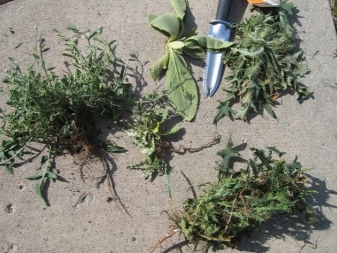
Most often, several types of weeds grow on lawns.
- Dandelion - herbaceous perennial with a powerful root system, reaching 50-60 cm deep. Dissected leaf plates, collected in large baskets. Flowering begins in April and lasts until July. Fruits are achenes, they are carried by a gust of wind throughout the territory of the site.
- Nettle - plant 60-200 cm high, aerial parts are covered with stinging hairs. Due to the powerful root system, it forms dense thickets.
- Clover - perennial with branched shoots. The leaf plates are rounded, trifoliate. Inflorescences are white or pink, ball-shaped. Flowering continues throughout the summer. In winter, it often freezes out, leaving defects in the form of unsightly bald spots on the green lawn.
- Creeping wheatgrass - a perennial plant that grows up to 1.5 m. The roots lie at a depth of 15-20 cm. The plant draws a lot of moisture from the ground, absorbs nutrients, thereby depleting the soil.
- Woodworm - an annual creeping plant. It rises immediately after the snow melts, flowering lasts until the first frost. This leads to the formation of a huge amount of seeds, which greatly complicates the control of this weed. One plant can bring up to 15-20 thousand seeds per year, and they remain viable for 3-6 years.
- Mary white - an annual herb with a high growth rate. It grows up to 2 meters, branches well. A developed root system takes a lot of water from the ground.
- Creeping buttercup Is a perennial plant with a short but branched rhizome. Stems grow up to 15-50 cm. Flowers are five-petalled, yellow.
Weeds cause great harm to the green canopy, and if not restrained, they can completely destroy cultivated grasses. All weeds are hardy and compete with lawn grass for space, micronutrients, moisture and sunlight. As a result, the cultivated grass fades, becomes lethargic, and over time is completely displaced.


Mechanical methods of struggle
Measures against weeds on the lawn should be carried out systematically - the seedlings of these plants are carried by the wind, birds, and also pets. They can get to the site with organic fertilizers and imported soil mixture. To remove all weeds from the territory, it is necessary to carry out the treatment many times per season, it is advisable to alternate different methods.
Hand weeding
The first weeding of the lawn is carried out 3 weeks after sowing. At this point, the rhizomes of the weeds are still poorly developed, so you can easily pull them out by hand. Dandelions, plantain, ivy bud and other herbs with a dense root system can be dug up with a narrowed scoop. Weeding is one of the most effective methods of weed control, but also the most time consuming.
Pulling out excess grasses should be throughout the growing season. If the soil is damaged during work, it is lightly irrigated and compacted.
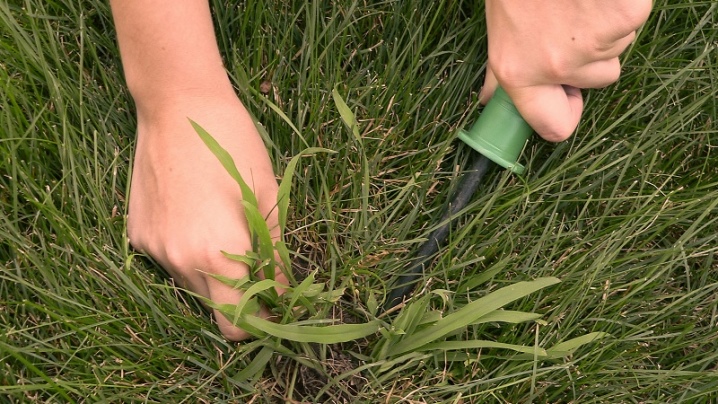
Processing with a special tool
You can get rid of excess herbs using specialized tools: a hoe, a flat cutter and a grass remover fork. They cut the ground part of the weeds at a sufficient depth in one movement. The main life processes pass through the leaf part of plants, therefore, the plant spends all its energy on growing new shoots. If the treatment is carried out regularly, then soon the growth of weeds stops.

A haircut
Periodic mowing allows you to effectively deal with meadow bluegrass, as well as woodlice and many other annual weeds. After mowing, cultivated grasses begin to actively grow lateral shoots and roots. Weeds in such conditions lack nutrients and stop in their development.
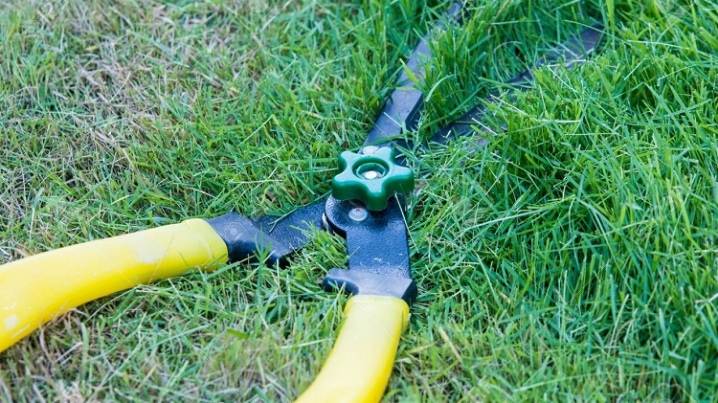
Herbicides
You can fight weeds with chemical agents - herbicides. They contain components that inhibit the growth of grass. Treatment can be done before sowing the lawn or as unwanted plants germinate. All funds are divided into 2 groups:
- contact - when it hits the ground parts of the plant, they damage its green tissues;
- systemic - they penetrate into the weed and spread toxic substances.
Chemistry gives the greatest effect when exposed to young plants, therefore it is advisable to spray spraying in the spring, when the very first shoots appear. In stores, drugs are sold in the form of liquids or granules - they should be diluted with water to obtain a solution of the required concentration.
Chemicals can be used in different ways: by applying to the ground or by spraying. In the first case, herbicides act in moist soil, when dry, the active ingredients become inactive, they remain in the ground and do not adversely affect cultivated plants. If the composition is applied by spraying, then for 3-4 hours it cannot be washed off with water.
Therefore, it is best to carry out the treatment immediately after irrigation or after rain.
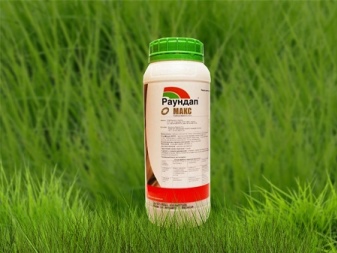
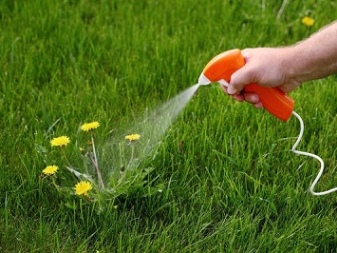
Continuous action
Continuous chemicals are used to irrigate the soil before planting a lawn grass mixture, as they destroy all vegetation from the land. Spraying the lawn with herbicides is carried out about 1.5 months before sowing the grass. Within a week, the weeds dry up and can simply be removed with a rake. The site is left for 3-4 weeks, after which it is re-processed and the earth is dug up.
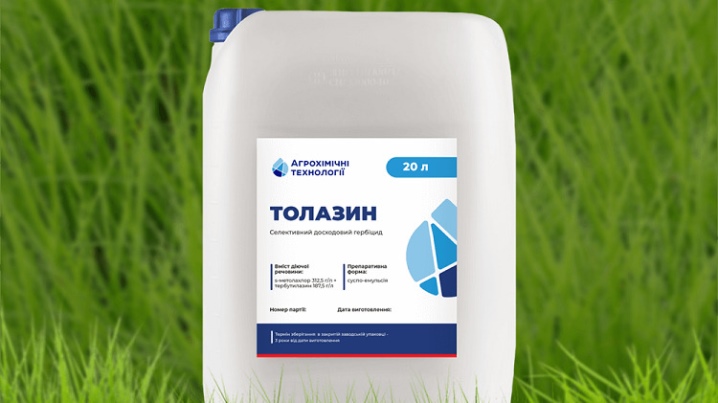
Selective action
On an already grown lawn, selective chemicals, for example, a compound called "Lontrel", give good results. They destroy only weeds, which die along with the root system. This does not cause any harm to the lawn grass.
Most often, several formulations are used.
- Lontrel. A systemic herbicide that penetrates green weed cells and destroys their vital functions. Able to remove dandelions and weeds of the Asteraceae family. It does not affect the grass mixture and strawberries. For processing, a solution is made up at the rate of 3 ml of the product per 5 liters of water. Weeds are treated by spraying after mowing the lawn. The consumption of the product is 5 liters per 100 m2.
- Gazontrel. An effective preparation for suppressing the growth of one- and two-year-old weeds. Effective against clover, buckwheat, as well as dandelion and chamomile. The active substance enters the tissues through the rhizome and the surface of the leaf plates and blocks their further development.The solution is made at the rate of 6 ml of the drug per 5 liters of water - the volume obtained will be enough to spray 100 m2 of the lawn.
- "Lintur". A systemic chemical that penetrates the tissues of weeds and stops their growth. Sold in the form of granules, when dissolved in water, forms a suspension that is applied to weeds by spraying. It is effective against problem crops such as Mary, chamomile, and some types of sow thistle. Processing is carried out in May - early June, spraying is allowed in early September. For 5 liters of warm water, take 2 g of herbicide.
- Deimos. Highly effective against annual and biennial weeds. It acts through the roots, as well as the green parts of plants, and is compatible with other herbicides. For all its effectiveness, it remains safe for cultivated herbs. The working solution is made up at the rate of 20 ml of the composition per 3 liters of water. This is enough to spray 100 m2 of lawn. Do not use near bodies of water, as it can kill aquatic flora and fauna.
- "Hacker". A systemic herbicide that has proven itself to be effective against dandelions, buttercups and other stubborn herbs. The solution is made up at the rate of 5 g of substance per 10 l of water, spraying is carried out 2-3 days after mowing.
- Agrokiller. An aqueous solution of this herbicide is used to control perennial weeds. It has a strong contact effect. To prepare a solution, 40 ml of the herbicide are mixed with 3 liters of water. Can be used at different temperatures.
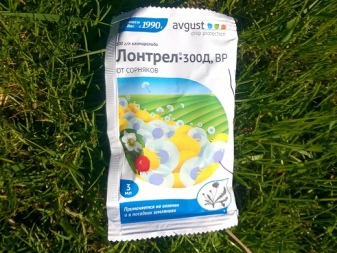

When treating weeds with chemicals, you must adhere to the following rules:
- do not spray during rain or before watering;
- exactly follow the dosage indicated by the manufacturer in the instructions;
- isolate young children and pets from the processing area;
- after spraying for 2-3 days, it is not recommended to walk on the lawn;
- you can process the lawn no earlier than 3-4 days after mowing the grass;
- unused leftovers should be stored in a cool dry place, out of the reach of children.
When working with any herbicides, you must observe safety measures. It is imperative to wear a respirator, goggles, as well as gloves and closed clothing - they protect the eyes, skin and respiratory system from contact with toxic compounds.
Don't expect instant herbicides. As a rule, they act for 1-2 months, however, their effectiveness is very high. They destroy not only the aerial part of the weeds, but also the roots with bulbs.
Please note that it is not recommended to combine treatment with fertilization - 10-15 days should pass between these procedures.


Folk remedies
You can eliminate weeds on the lawns with the help of folk remedies. Since ancient times, our grandparents used vinegar, salt and laundry soap to destroy unwanted vegetation. They are freely sold in any store, and they are also safe for people and pets. However, their action is selective - they give results only on individual plants.
Important: when they get into the ground, these components significantly impair its fertility, therefore, such techniques must be used in dosage.
- Salt solution. In a bucket of water, 1 kg of table salt is diluted, mixed and used for irrigation.
- Soap + soda. Dissolve a handful of baking soda and a piece of grated laundry soap in a bucket of warm water.
- Vinegar. To remove some types of weeds, 9% vinegar is mixed with lemon squeeze in a ratio of 3 to 1. A few days after such treatment, it is imperative to add wood ash to the ground, since vinegar strongly acidifies the soil.
- Vinegar + salt + soap. The most gentle method, does not have a detrimental effect on the quality of the soil. For a bucket of water, you need to take 1 liter of vinegar, a bar of crushed soap and 100 g of salt. The solution is mixed and watered with weeds.After processing, you need to add wood ash.

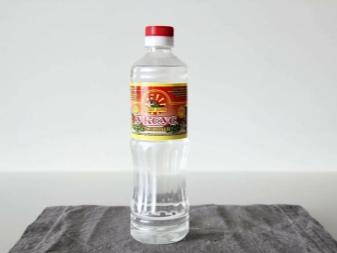
Prevention of overgrowing of the lawn with weeds
An indispensable factor in the successful fight against any weeds is compliance with the requirements of agricultural technology. It is necessary to create conditions on the site that are favorable for the growth of cultivated plants - then the risk of weeds is significantly reduced.
- High quality turf. Grass mix for sowing lawn should only be purchased from trusted suppliers - this is the only guarantee that the seed material does not include weed seedlings.
- Aeration. High humidity and lack of oxygen access to the roots create conditions for the rapid germination of weed seeds and the appearance of pests. To improve the flow of air into the soil, it is necessary to pierce the ground with garden shears from time to time.
- A haircut. This procedure has a positive effect on the growth of lawn grasses, stimulates the intensive development of lateral shoots. As a result, weeds do not receive enough nutrition - and the plants stop growing. A haircut should be done at least once every 10-14 days, the height of the grass should be maintained at 5-8 cm.
- Weeding. To eliminate single weeds, it is better to use a manual method of removing them without the use of herbicides. You need to pull them out completely together with the roots.
- Nitrogen fertilizers. Most of the weeds cannot tolerate excess nitrogen, so the use of urea-based fertilizers, as well as ammonium nitrate or nitrophoska, will be a good solution to protect the lawn.
- Mulching. In the autumn, the lawn is covered with sawdust. Their dense layer does not allow weeds to break through.
A fairly good result is given by systematic sweeping of the lawn with a rake - this way you can remove all the weeds along with the shoots.
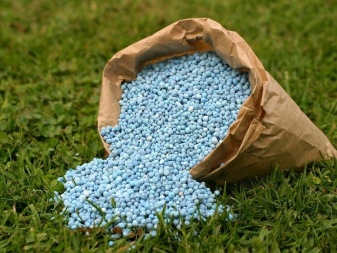
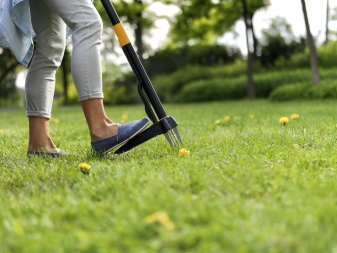
For information on how to get rid of weeds on the lawn, see the next video.



































































The comment was sent successfully.